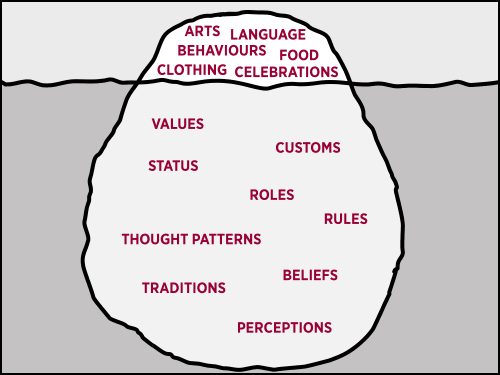What is cultural literacy?
You have cultural literacy when you know what an average member of that culture would be expected to know, which is usually assumed and often unstated (Hirsch, 1983). Hirsch (1983) developed the term "cultural literacy" because people can't learn reading, writing, and other communication as skills separate from the culturally assumed knowledge that shapes what people communicate about. For example, the meaning of many words is culture-specific. Telling someone you wear thongs to the beach in Australia is common, but it would have a very different reaction in the USA!
Cultural literacy is culture-specific. There are too many different cultures to be literate in all of them. Most people have a fluent cultural literacy in their culture of origin, as they will have been learning their culture's assumed knowledge from childhood. You will need to develop new cultural literacies when you enter a new culture, or interact with members of that culture.
What is the assumed knowledge of a culture?
 Culture is often described as being like an iceberg. Above the water are the aspects of the culture that you can easily see and experience: language, dress, food, festivals and the like. Below the water, where you can't see it, are the aspects of the culture that those within the
culture know and understand, often without thinking about it or questioning it.
Culture is often described as being like an iceberg. Above the water are the aspects of the culture that you can easily see and experience: language, dress, food, festivals and the like. Below the water, where you can't see it, are the aspects of the culture that those within the
culture know and understand, often without thinking about it or questioning it.
The unspoken aspects of a culture are influenced by its history, values, and assumptions, and range from perceptions of right and wrong, gender and other roles, and customs like use of personal space, to idiomatic language use (language based on assumed knowledge). For example, people from English-speaking cultures usually know what a "white elephant" is (a possession or gift that has no use and is expensive or difficult to keep), but the term makes no sense unless you know what its meaning is in the culture.
Assumed knowledge and values have real impact on people's lives. One example is racism, in which people do not have an understanding or valuing of the other culture or peoples, and negatively stereotype its members. Racism can lead to discrimination, exclusion, and even violence.
Another example is gender and gender roles. Many cultures recognise only male and female genders, and have assumptions about what a man or a woman should be, or do: how to behave, what to wear, what kinds of work they can do. "Men are strong" and "women are caring" are two examples of cultural assumptions about gender. People who don't match up to the assumptions may be judged negatively.
Culture can also be specific to workplaces or institutions. When you first arrived at university, did you feel like you didn't understand much of what was going on? The values, customs, and language and terminology used at university have to be learned like any other culture. Words such as 'referencing' have meanings, expectations, assumptions, and right-and-wrongs that may often be unstated.
'Cultural iceberg' image adapted from "Activity 1: Exploring your Cultural Iceberg," by Together for Humanity Foundation Ltd, n.d. (http://www.differencedifferently.edu.au/everyone/part_1b.php). Creative Commons License (CC BY-NC 3.0 (opens in a new window)).
References
Hirsch, E. (1983). Cultural literacy. The American Scholar, 52(2), 159-169. Retrieved from http://www.jstor.org/stable/41211231
Mobile options:

